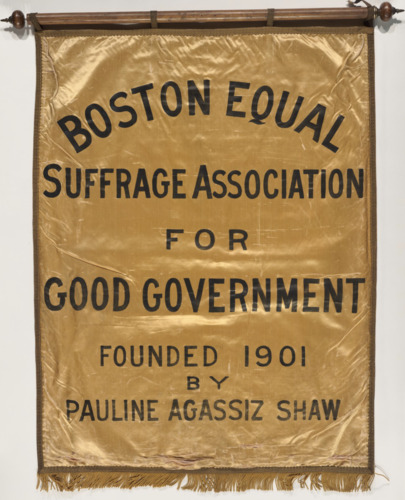Last updated: February 21, 2025
Place
Site of the Boston Equal Suffrage Association for Good Government (BESAGG) Office

Norman B. Leventhal Map Center, Boston Public Library
The 1901 Boston Equal Suffrage Association for Good Government (BESAGG) originated as a civic organization dedicated to social reform. While interested in a variety of social issues, BESAGG soon shifted its primary goals to focus on women’s full enfranchisement and civic education, believing reforms would more likely occur if women had the ballot.1 Its founders included the talented local suffragists Pauline Agassiz Shaw, Maud Wood Park, and Mary Hutcheson Page. Though of different generations, these three women brought a renewed strength to the suffrage movement in Massachusetts.2
BESAGG represented a new generation of women interested in progressive reform and women’s rights. Called New England’s “most innovative woman suffrage group” by historian Sharon Hartman Strom, leaders looked to the tactics of English militant suffragettes for inspiration.3
Leaders of BESAGG encouraged taking the suffrage cause directly to the people through open-air meetings and rallies. The organization strove to maintain a highly visible presence in the landscape of Boston, establishing its popular Sunflower Lunchroom on Cornhill and later Tremont Street, as well as its Votes for Women Shop. Members also sought support among a wider variety of women, including those of different class, racial, ethnic, or religious backgrounds.4 With its more aggressive campaigning, BESAGG helped regenerate support for the suffrage movement in twentieth-century Boston.

Banner for BESAGG. (Credit: Schlesinger Library, Radcliffe College, Harvard University.)
While BESAGG had several different office locations throughout its 20 year history, including at 6 Beacon Street and 167 Tremont Street, its most recognizable office is arguably 585 Boylston street. Called a “Busy Hive” for suffrage activity by The Boston American in 1913, 585 Boylston street also held the offices of the Massachusetts Woman Suffrage Association, The Woman's Journal, the Boston chapters of the Woman Suffrage Party (a political party that BESAGG members helped organize), and the College Equal Suffrage League.5

585 Boylston Street, the home of several suffrage organizations. (Credit: Boston Public Library.)
In 1920, following the ratification of the 19th Amendment in Massachusetts, BESAGG transitioned to its new purpose of encouraging civic education and participation through the Boston League of Women Voters.
Footnotes:
- Sharon Hartman Strom, “Leadership and Tactics in the American Woman Suffrage Movement: A New Perspective from Massachusetts,” The Journal of American History 62, no. 2 (1975): 296-315; Sharon Hartman Strom, Political Woman: Florence Luscomb and the Legacy of Radical Reform (Philadelphia: Temple University Press, 2001); Patricia Marzzacco, “ ‘The Obligation of Opportunity’: Maud Wood Park, The College Equal Suffrage League and the Response of Women Students in Massachusetts Colleges, 1900-1920.” (PhD diss., Harvard University, 2003).
- Strom, “Leadership and Tactics in the American Woman Suffrage Movement: A New Perspective from Massachusetts,” 296-315; Barbara Berenson, Massachusetts in the Woman Suffrage Movement (Charleston, South Carolina: The History Press, 2018), 111-113.
- Strom, Political Woman, 69-70; Berenson, Massachusetts in the Woman Suffrage Movement, 111-113.
- Strom, Political Woman, 69-70; Berenson, Massachusetts in the Woman Suffrage Movement.
- Maud Wood Park, “Busy Hive Full of Workers for Women,” The Boston American, Feb 23, 1913. Independent Historian Lyle Nyberg has tracked many of the locations of Boston suffrage organizations. For more information, please visit the webpage Suffrage Organizations of Boston.
